In the powder processing industry, the mixer is one of the most essential pieces of equipment. Whether in the pharmaceutical, food, chemical, feed, or additive sectors, the efficiency, mixing uniformity, cleaning convenience, and maintenance cost of a mixer directly determine product quality and overall production efficiency.
Hywell Machinery, as a professional manufacturer of powder processing equipment in China, designs and produces both 2D powder mixers (rocking powder mixers) and V powder mixers. Both models have been widely applied by customers worldwide for blending a variety of powders and granules. With decades of experience in manufacturing, Hywell has accumulated deep technical know-how in both types of mixers, allowing for a fair and practical comparison based on actual industrial performance.
Among the many types of powder mixing machines, two of the most widely used are the 2D powder mixer (also called rocking powder mixer) and the V powder mixer. Although both belong to the category of gravity-type mixers without internal agitators, they differ significantly in mechanical structure, motion principle, mixing performance, and industrial applicability.
This article presents a detailed comparison between the two machines to help users choose the right equipment for their production needs.
2D powder mixers are primarily designed for factories with limited workshop space but high production capacity, as they are low-profile and can achieve a maximum output of 6 tons per batch. Due to the V-shaped mixer structure, it is high and therefore cannot achieve large output. The recommended maximum volume is within 5000L.
1. Structural Design and Working Principle
1.1 V Powder Mixer
The V powder mixer consists of two asymmetrical cylinders joined together to form a “V”-shaped container. During operation, the material continuously flows, merges, and separates between the two arms of the V. Since there is no internal agitator, the mixing relies mainly on the gravity-driven tumbling motion of the materials.
The structure of the V mixer is simple, cost-effective, and easy to operate, which explains its long-standing popularity in the pharmaceutical and food industries.
However, the mixing mechanism is essentially diffusive, meaning the materials mix through random motion and layer displacement. When there are significant differences in particle size or bulk density among the materials, the V mixer tends to produce segregation, limiting its uniformity performance.
1.2 2D Powder Mixer (Rocking Powder Mixer)
The 2D powder mixer consists of a rotating drum mounted on a rocking frame. During operation, the drum not only rotates around its own central axis but also swings horizontally along another axis.
This dual motion causes the material inside the drum to move in complex patterns — rotating, tumbling, and interflowing, producing both diffusion and convection effects.
As a result, the 2D mixer provides a much higher mixing intensity and uniformity compared with the single-motion V mixer. Its design features reinforced drive components, balanced support bearings, and a stable transmission system, ensuring longer service life and smoother operation.
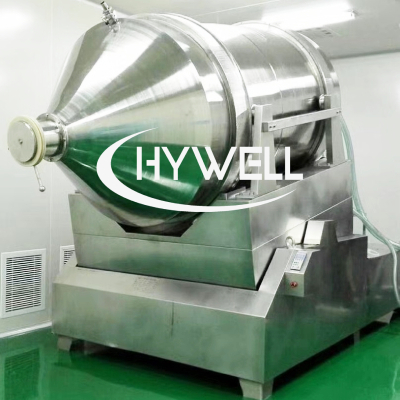
2D Powder Mixer
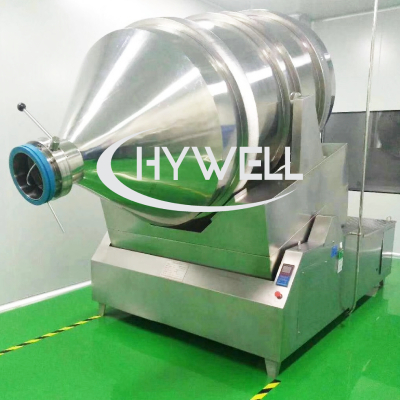
2D Powder Mixer

Rocking Powder Mixer
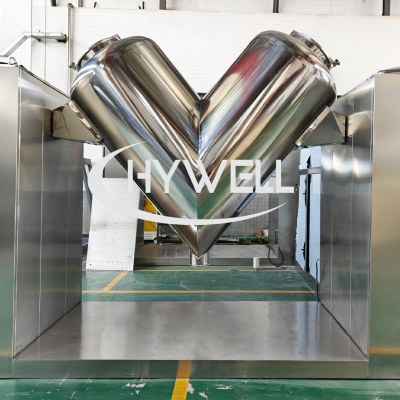
V Powder Mixer
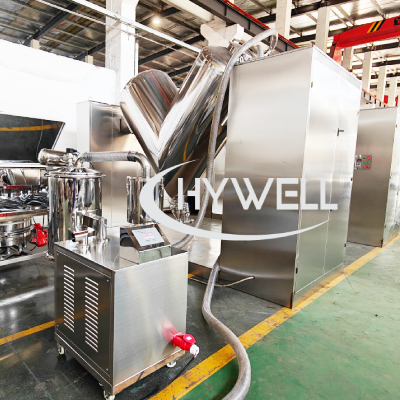
V Powder Mixer
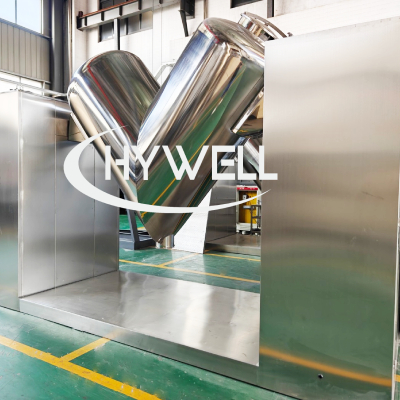
V Powder Mixer
2. Mixing Uniformity and Efficiency
2.1 Mixing Uniformity
In powder processing, mixing uniformity is the most critical performance parameter.
Under identical volume and loading ratios, the 2D powder mixer provides a more complex material movement pattern with almost no dead zones or stagnation areas inside the drum.
Experimental results indicate that:
The 2D mixer can achieve uniformity above 99%, while the V mixer usually ranges between 90–95%, and this figure decreases sharply when the materials differ in density or particle size.
Therefore, in industries that require high blending precision — such as pharmaceuticals, enzyme granules, flavor additives, or functional powders — the 2D mixer clearly demonstrates superior performance.
2.2 Mixing Time and Energy Consumption
Because of its multi-directional motion, the 2D mixer completes the mixing process faster — often 30–50% shorter than that of a V mixer.
For example the V mixer might need about 15 minutes to achieve a uniform blend while the 2D mixer can reach the same uniformity in 8–10 minutes.
Although its structure is more sophisticated, its energy consumption per unit of mixed material is actually lower due to higher efficiency. For large-scale or continuous batch production, this translates into higher throughput and lower operating cost.
2.3 6000L 2D Powder Mixer Video
2.4 V Type Powder Mixer Video
3. Material Applicability and Industry Usage
3.1 Applications of V Powder Mixer
The V-type mixer is mainly suitable for (1) free-flowing powders or granules, (2) materials with similar particle size and density, and (3) formulations where ultra-high uniformity is not required.
Common applications include starch, cocoa powder, sugar, coffee, and feed premixes.
In these cases, its simple structure and low maintenance cost make it a practical solution.
3.2 Applications of 2D Powder Mixer
The 2D powder mixer, on the other hand, can handle more complex formulations such as (1) materials with varying particle sizes or densities, (2) powders prone to layering or agglomeration, and (3) blends containing small proportions of active or micro-ingredients.
Therefore, the 2D mixer is widely used in pharmaceuticals, functional food ingredients, catalysts, ceramic powders, new energy materials, and detergent granule production.
In particular, for enzyme granules in detergent production, or pharmaceutical excipient blending, where high uniformity and batch-to-batch consistency are critical, the 2D mixer is often the preferred choice.
4. Cleaning, Maintenance, and Ease of Operation
4.1 Cleaning Process
The V powder mixer is easy to clean because of its simple structure, making it suitable for single-product or small-batch operations. However, due to the V shape, dead corners may form at the intersection of the two cylinders, causing material residue — a potential issue for sticky or electrostatic powders.
In contrast, the 2D powder mixer has a cylindrical or oval drum with a highly polished inner surface, ensuring minimal residue and easy discharge. Many modern 2D mixers are equipped with automatic tilting and quick-detach cleaning systems, significantly improving cleaning efficiency.
This advantage is particularly important in industries that must comply with GMP or HACCP standards.
4.2 Maintenance and Operation
The V mixer’s simple mechanical structure means low initial maintenance cost, but its bearings and seals wear out faster during prolonged use.
The 2D mixer, though more complex, features frequency control, dust-proof seals, automatic stop positioning, and other smart design elements that extend maintenance intervals and improve ease of use.
In continuous or automated production environments, the 2D mixer provides greater operational stability and less downtime.
5. Automation and Safety Performance
5.1 Automation Control
Most traditional V mixers are operated manually or with basic electric switches, lacking precise control functions.
The 2D mixer, by contrast, is often integrated with a PLC system, enabling control over rotation speed, mixing time, automatic positioning, and fault alarms.
This allows seamless integration with upstream feeders and downstream packaging systems, supporting fully automated powder processing lines.
5.2 Safety Protection
The V mixer’s unbalanced geometry can sometimes lead to vibration or mechanical stress when overloaded.
The 2D mixer, with its well-balanced design, operates smoothly and incorporates multiple safety features such as emergency stop, torque overload detection, and interlocked protective covers.
This makes the 2D mixer safer and more compliant with modern manufacturing requirements, especially in the pharmaceutical and food sectors.
6. Cost and Economic Evaluation
From a purely equipment cost perspective, the V powder mixer is cheaper — ideal for small factories, laboratories, or applications with limited budgets. The 2D mixer, being more sophisticated in structure and control, typically costs 1.3 to 1.8 times more than a V mixer of the same volume.
However, considering long-term operational economics, the 2D mixer delivers higher productivity, lower energy use, and longer lifespan.
In continuous batch production, the extra investment can usually be recovered within one to two years through savings in time and maintenance.
7. Comprehensive Comparison Table
Item | 2D Powder Mixer (Rocking Mixer) | V Powder Mixer |
Motion Principle | Rotation + Rocking (Two-dimensional) | Single-axis rotation |
Mixing Uniformity | Very High (≥99%) | Medium (90–95%) |
Suitable Materials | Powders with different densities or sizes | Free-flowing, uniform powders |
Mixing Time | Short (8–10 min) | Longer (≈15 min) |
Cleaning | Easy, no dead corners | Some dead zones |
Maintenance | Longer cycle, less frequent | Simple but frequent |
Automation | PLC control optional | Mostly manual |
Price | Higher | Lower |
Typical Industries | Pharmaceuticals, food additives, chemicals | Food, feed, general powders |
8. Market Trend and Selection Advice
With the growing adoption of automation and GMP compliance, powder mixing equipment is evolving toward higher efficiency, intelligence, and cleanliness.
The 2D powder mixer, as a representative of this new generation, is rapidly replacing the traditional V mixer in many industrial applications.
For companies still using V-type mixers, upgrading to a 2D model is highly recommended when product quality, homogeneity, or productivity requirements increase.
However, for laboratories, small-batch manufacturing, or frequent product changeovers, the V mixer remains a reasonable and economical choice due to its simplicity and low cost.
Ultimately, the selection should depend on material characteristics, required mixing precision, and production scale.
9. Conclusion
In conclusion, both the 2D powder mixer and the V-type mixer represent efficient and reliable powder blending solutions developed by Hywell Machinery. Each model offers distinct advantages that meet different production needs.
The 2D powder mixer provides higher blending uniformity and better handling of complex formulations with varying particle sizes or densities. It is ideal for industries that require precise mixing results, such as pharmaceuticals, food, and chemical processing.
The V-type mixer, on the other hand, remains a classic and economical choice for gentle blending of dry and free-flowing powders. Its simple structure, easy cleaning, and low energy consumption make it especially suitable for small- and medium-scale production.
Ultimately, choosing between the two depends on your material properties, production capacity, and desired mixing performance. As a professional manufacturer, Hywell Machinery offers both models with customized design options to ensure optimal performance for every customer’s process.
English
Русский
العربية
Français
Español
Português
Deutsch
italiano
日本語
한국어
Nederlands
Tiếng Việt
ไทย
Polski
Türkçe
ພາສາລາວ
Bahasa Melayu
Filipino
Bahasa Indonesia
magyar
Română
Čeština
қазақ
Српски
हिन्दी
فارسی
Slovenčina
Slovenščina
Norsk
Svenska
українська
Ελληνικά
Suomi
Հայերեն
עברית
Dansk
اردو
বাংলা
Hrvatski
Afrikaans
Gaeilge
Eesti keel
Māori
नेपाली
Oʻzbekcha
latviešu
Azərbaycan dili
Беларуская мова
Български
ქართული
Kurdî
Кыргызча

 简体中文
简体中文









